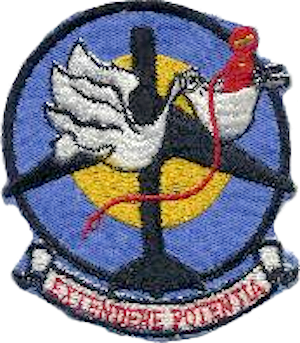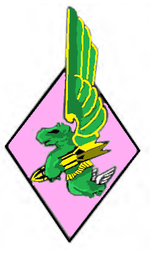
The 460th Wing is an inactive wing of the United States Air Force. The 460th Space Wing was activated on 1 October 2001, replacing the 821st Space Group. It was inactivated on 24 July 2020 and replaced by the Buckley Garrison.

The 462d Air Expeditionary Group is a provisional unit of the United States Air Force. It is assigned to Air Mobility Command to activate or inactivate as needed to meet operational requirements. Its last assignment was at Naval Support Facility Diego Garcia, British Indian Ocean Territory.

The 331st Bombardment Group is an inactive United States Air Force unit. It was last assigned to the 315th Bombardment Wing, being stationed at Northwest Field, Guam. It was inactivated on 15 April 1946.

The 346th Bombardment Group is a former United States Army Air Forces unit. It was last assigned to the 316th Bombardment Wing at Kadena Airfield, Okinawa, where it was inactivated on 30 June 1946. The group was originally a heavy bomber training unit, but was inactivated in a general reorganization of Army Air Forces training units in 1944. It was reorganized as a Boeing B-29 Superfortress group later that year. It moved to Okinawa in 1945, but arrived too late to participate in combat.

The 731st Airlift Squadron is a flying unit of the United States Air Force assigned to the Air Force Reserve Command and part of the 302d Airlift Wing at Peterson Air Force Base, Colorado. It operates Lockheed C-130H Hercules aircraft providing global airlift. The squadron also has the specialized mission of Modular Airborne Fire Fighting System.

The United States Air Force's 9th Combat Operations Squadron is an Air Force Reserve Command space operations unit located at Vandenberg Space Force Base, California. The 9th augments the 614th Air and Space Operations Center in operating the Joint Space Operations Center, performing combat operations, plans, strategy and intelligence assessments that enable the Commander, Joint Functional Component Command for Space to command and control space forces by providing worldwide space effects and theater support to combatant commanders.

The 970th Airborne Air Control Squadron is part of the 513th Air Control Group at Tinker Air Force Base, Oklahoma. It operates the Boeing E-3 Sentry aircraft conducting airborne command and control missions.

The 19th Electronic Warfare Squadron is an active United States Air Force unit, stationed in Bann, Germany as part of the United States Air Forces in Europe Warrior Preparation Center. It was first activated during World War II as the 19th Photographic Mapping Squadron. During the war, the squadron remained in the United States and mapped areas of North America. However, starting in 1944, the air echelon of the squadron deployed to North Africa to map that area. After V-E Day, the squadron moved to England and mapped large areas of Europe until October 1945, when it began to stand down for inactivation. It was briefly active in the reserve from 1947 to 1949 as the 19th Reconnaissance Squadron.

The 25th Attack Group is an active United States Air Force unit, stationed at Shaw Air Force Base, South Carolina. It was activated in February 2018 as a geographically separate unit to operate unmanned aerial vehicles and is assigned to the 432d Wing, which is located at Creech Air Force Base, Nevada. As of 2020, the group manages five General Atomics MQ-9 Reaper attack squadrons, as well as the 25th Operations Support Squadron, which provides intelligence, weather, and administrative support.

The 768th Bombardment Squadron is an inactive United States Air Force unit. It was last assigned to the 462d Strategic Aerospace Wing at Larson Air Force Base, Washington, where it was inactivated on 25 June 1966. The squadron was first activated in 1943, and became one of the earliest Boeing B-29 Superfortress units. It moved to the China Burma India Theater in April 1944 and participated in the first attack on the Japanese Home Islands since the 1942 Doolittle Raid on 15 June 1944. It earned three Distinguished Unit Citations. The squadron moved to Tinian with the rest of the 58th Bombardment Wing in April 1945 and continued its participation in the strategic bombing campaign against Japan until V-J Day. In November 1945, it returned to the United States, where it was inactivated in April 1946.

The United States Air Force's 10th Intelligence Support Squadron is an intelligence unit located at Langley Air Force Base, Virginia.

The 513th Electronic Warfare Squadron is a United States Air Force unit assigned to the 350th Spectrum Warfare Group at Eglin Air Force Base, Florida.

The 361st Expeditionary Reconnaissance Squadron is a provisional United States Air Force unit. It was most recently assigned to the 451st Air Expeditionary Group at Kandahar Airfield, Afghanistan, where it was inactivated on 1 September 2014.

The 461st Bombardment Squadron is an inactive United States Air Force unit. Its last assignment was with 346th Bombardment Group at Kadena Airfield, Okinawa, where it was inactivated on 30 June 1946. From 1942 the squadron served as a Replacement Training Unit for heavy bomber aircrews. It was inactivated in the spring of 1944 in a general reorganization of Army Air Forces training units. The squadron was activated again in 1944 as a Boeing B-29 Superfortress unit. Although it deployed to the Pacific, it arrived too late to see combat service.

The 463d Bombardment Squadron is an inactive United States Air Force unit. Its last assignment was with 346th Bombardment Group at Kadena Airfield, Okinawa, where it was inactivated on 30 June 1946. From 1942 the squadron served as a replacement training unit for heavy bomber aircrews. It was inactivated in the spring of 1944 in a general reorganization of Army Air Forces training units. The squadron was activated again in 1944 as a Boeing B-29 Superfortress unit. Although it deployed to the Pacific, it arrived too late to see combat service.

The 464th Bombardment Squadron is an inactive United States Air Force unit. Its last assignment was with the 382d Bombardment Group at Camp Anza, California, where it was inactivated on 4 January 1946. From activation in 1942 the squadron served as a replacement training unit for heavy bomber aircrews. It was inactivated in the spring of 1944 in a general reorganization of Army Air Forces training units. The squadron was activated again in September 1944 as a Boeing B-29 Superfortress unit. Its ground echelon deployed to the Pacific in 1945, but arrived too late to see combat.

The 308th Air Refueling Squadron is an inactive United States Air Force unit. It was last assigned to the 2d Bombardment Wing at Hunter AFB, Georgia. It was inactivated on 1 March 1960.

The 7th Bombardment Squadron is an inactive United States Air Force unit. It was last assigned to the 34th Bombardment Group at Sioux Falls Army Air Field, South Dakota, where it was inactivated on 28 August 1945.

The 333d Special Operations Wing is an inactive United States Air Force unit. It was active from July 1968 through March 1970 at Pleiku Air Base, South Vietnam. In 1985, the wing was consolidated with the 333d Bombardment Group as the 333d Special Operations Wing.

The 928th Expeditionary Air Refueling Squadron is a provisional unit of the United States Air Force. It is assigned to Air Mobility Command to activate or inactivate as needed for contingency operations.





















